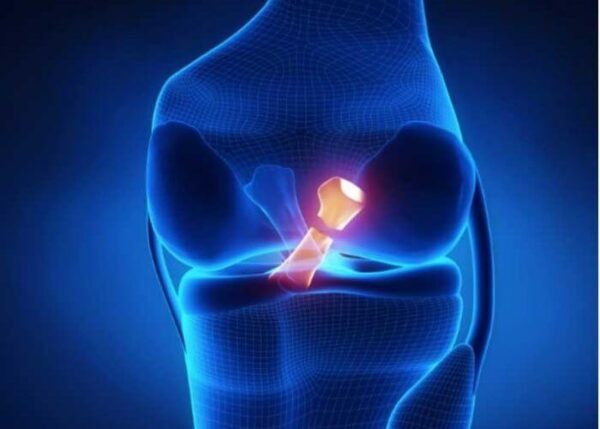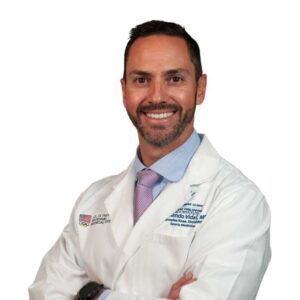Do I have an ACL Tear?
It’s the phrase no athlete wants to hear: “You’ve torn your ACL.” Those dreaded three letters sends shivers down any athlete’s spine. In the recent past, a torn ACL meant a career-ending injury, early osteoarthritis and knee problems for the future. Thankfully, techniques to repair and reconstruct the ACL have advanced considerably in the past few years and as such, our ability to return an athlete to sport has also advanced. Dr. Armando Vidal, orthopedic knee specialist serving Vail, Aspen and the surrounding Denver, Colorado communities, has extensive experience treating ACL tears and other ligament injuries in the knee in athletes of all levels – recreational, collegiate and professional.

What is an ACL tear?
The anterior cruciate ligament, or ACL, is one of the four major ligaments that make up the knee joint complex. The ligaments help stabilize the knee, keeping the femur (thigh bone) in the correct alignment with the tibia (shin bone) while allowing the joint to flex, extend and employ muscle power through its many duties. The ACL, which runs down the center of the knee from the front of the tibia to the back of the femur, is critical to maintaining the stability of the knee joint. An injury to the ACL occurs when the ligament is stretched beyond its normal range and the tibia slips out from under the femur.
How did I tear my ACL?
A torn ACL is one of the most common sports-related injuries. Despite the general impression that these injuries occur from a direct impact to the knee – most (80%) of these injuries occur from a non-contact mechanism. It is common for an athlete to describe a mechanism where they cut hard, felt a shift and a “pop”. Typically, field (lacrosse, soccer, football), court (basketball and volleyball) and winter (skiing and snowboarding) athletes have the highest risk. Additionally, female athletes are 3 to 5 times more likely to tear their ACL than their male counterparts despite the media attention on the male athlete.
What are the symptoms of a torn ACL?
Individuals who experience an ACL tear often report the following symptoms:
- Pain, often sudden and severe (often on the outside of the knee)
- A popping sound often heard at the time of injury
- Rapid onset of swelling (within 24hr)
- Limited range of motion
- Knee instability – the knee feeling as it will collapse or “give way”
- Inability to stand or walk without pain and difficulty
- Inability to return to play in the same contest as the injury
Is it possible to prevent an ACL tear?
In short, the risk can be reduced but not eliminated entirely. Although several risk factors exist, only the biomechanical ones are modifiable. Optimizing biomechanics is key to prevention of an ACL injury, ACL graft re-injury or an injury to the contralateral (other, uninjured) knee.
Dr. Vidal’s research has shown that the risk of tearing the ACL in the contralateral knee is about 3% over the first 2 years after the first ACL injury. Partnering with a surgeon like Dr. Vidal, who understands this, is key to a successful career beyond an ACL injury. His focus is not just on the knee that was repaired but on the patient’s risk as a whole. He is able to ensure that patients in the greater Denver, Colorado area are partnered with a therapist who will help address any underlying risk factors during recovery.
Dr. Vidal knows the best way to minimize the risk of tearing your ACL is to train and condition in your sport year-round. Other ways to avoid an ACL tear include:
- Practicing proper landing techniques after jumping
- Reduce stress on the ACT during a pivoting turn by bending at the knees and hips, in a crouch-position.
- Muscle strength exercises, specifically for the quadriceps (front of the thigh) and the hamstrings (back of the thigh). Since these muscles work together to bend or straighten the leg, strengthening helps protect the leg against knee injuries.
How common is an ACL re-tear?
This is not a simple question to answer. ACL re-injury is a complex scenario and has many variables to consider. The key to preventing ACL re-injury is to partner with a surgeon who understands the entire continuum that is involved in successful ACL recovery.
Here are just a few of the factors that influence a patient’s risk of reinjury:
- Timing of Surgery
- Graft Choice and placement
- Management of Cartilage and Meniscal Injury
- Recognition of significant collateral (MCL, FCL) injury and appropriate intervention
- Guided, evidence-based rehabilitation program
- Validated and evidence-based return to play program and test
- Brace (certain sports)
- Psychological Readiness for return to sport
If you’ve torn your ACL, statistics will tell you the likelihood of re-tearing the anterior cruciate ligament is six times greater within the first 24 months after surgery, than in someone who has never torn their ACL. Although only 3-10% of grafts fail, this is still a large number of cases. There can be many reasons for an ACL reconstruction failure.
What is surprising, is the most common occurrence of a re-tear is not related to a new trauma. Instead, post-surgical problems with the original ACL graft are the most common reason for a retear, or failure of a first surgery. For that reason, it is important to see Dr. Vidal, who performs hundreds of successful ACL reconstructions a year. Unlike many surgeons who only complete 10 ACL surgeries a year, Dr. Vidal and his colleagues at the Steadman Clinic lead the industry in ACL reconstruction. He knows the importance of proper surgical technique, graft placement and post-surgical rehabilitation.
The second most common cause of ACL reconstruction failure is due to secondary instabilities that should have been addressed during the original surgery. Those include, but may not be limited to a PCL injury, medial knee injury or posterolateral corner injury. Dr. Vidal is known for taking his time and doing a proper ACL repair or reconstruction and repairing any secondary issues if necessary.
How long does it take to recover after a torn ACL?
Each patient’s recovery time is a very individualized and depends a great deal on the amount of reconstruction required and a patient’s return to sport goals and timeline. In general, patients can expect the following:
- Return to work or school in as little as 5 days.
- Physical therapy started almost immediately after reconstruction.
- A careful, comprehensive and evidence-based rehabilitation plan prescribed by Dr. Vidal.
Many fitness activities can resume between 6-12 weeks after surgery. Full return to sport is made as a joint decision between Dr. Vidal and your therapist. High demand athletes must pass a “return to sport” test in order to be cleared. Most of Dr. Vidal’s patients can return to their regular sports activities 7-9 months after surgery.
ACL Knee Injury Specialist
An ACL injury is one of the most common injuries experienced by athletes, especially female athletes. A torn ACL may be caused by a direct impact to the knee, or by sudden twists or stops. ACL injury specialist, Doctor Armando Vidal provides diagnosis and treatment options for patients in Vail, Aspen, and the surrounding Denver, Colorado communities who have experienced an injury to the ACL. Contact Dr. Vidal’s team today!

Locations
180 S Frontage Rd W
Vail, CO 81657
226 Lusher Court
Ste 101
Frisco, CO 80443
322 Beard Creek Road
Edwards, CO 81632


